this is an out-of-character page about Astarey
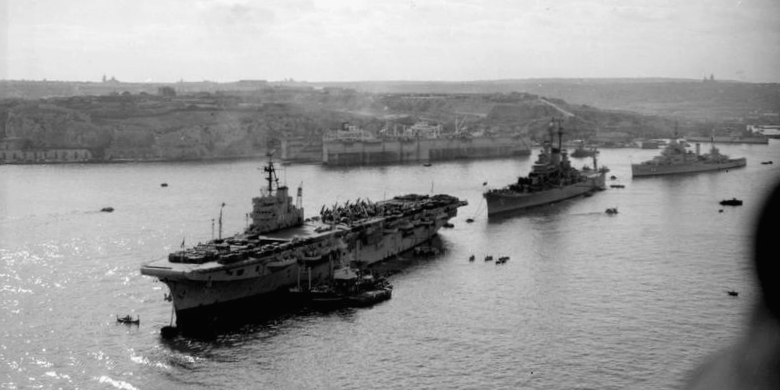
Astarese ships near port, 1997- in front is Carrier #29 Loyalty, the second ship of the Patriotism class of light aircraft carriers; behind it is the recently-launched Battleship #1 Mardo, still the only ship of the Capital class of cruisers; and last is the then-decommissioned Cruiser #60- also named Mardo- the 9th and last ship of the City class of light cruisers.
The National Navy of the Commonwealth of Astarey is the principal military force of the Commonwealth of Astarey. Established in a relatively modern form shortly after the Proclamation of the Commonwealth in Fogiretesz in 1821, it unsually gives primacy to the Navy- the National Navy of the Commonwealth of Astarey's Surface Naval Forces' Fleet Command technically has control over the other eight branches of the Navy, though in practice only exercises its authority over the other Naval Forces (with the only unified command being the Astarese government proper). The nine branches, with their major sub-branches and commands, by age, are:
- NNCA Surface Naval Forces
- NNCA-SNF Fleet Command (official command of the entire Navy, also operates primary combatants)
- NNCA-SNF Heavy Combatant Command (organized to operate Astarese battleships, of which only one exists- though international observers deem it a cruiser)
- NNCA-SNF Artillery & Battery Command (controls coast & sea forts, as well as several interior bases and former Coastal Defense Command)
- NNCA-SNF Sealift & Auxilliary Command (controls transport and formerly hospital ships, divided into Programs)
- NNCA-SNF Carrier & Amphibious Command (operates carriers for Naval Infantry and Aviation forces)
- NNCA-SNF Riverine Prefecture (originally part of the Coastal Guard, 'elevated' in a highly controversial move, responsible for minelaying and sweeping)
- NNCA-SNF Special Warfare Command
- NNCA-SNF Helicopter Command (controls most parts of the SNF's aerial forces not controlled by Naval Aviation, formerly operated cruiser-launched aircraft and seaplanes as Aircraft Command)
- NNCA-SNF Aerial Prefecture (operates anti-submarine aircraft and weaponry)
- NNCA-SNF Cyber Command
- NNCA Ground Forces (originally the Astarese Army)
- NNCA-GF Infantry Command
- NNCA-GF Cavalry Branch
- NNCA-GF Artillery Command
- NNCA-GF Armored Command (operates armored fighting vehicles)
- NNCA-GF Army Air Forces (separate from what became the Aerospace Forces, initially the Aeronautics Section of the NNCA-GF Signalling Corps before the Signalling Corps was itself separated)
- NNCA-GF Supply Branch (handles logistical needs of other Commands, as well as operating several logistical and landing ships)
- NNCA-GF Air Defense Artillery Corps
- NNCA-GF Special Operations Branch
- NNCA Naval Infantry Forces
- NNCA-NIF Fleet Operations Division
- NNCA-NIF Ground Defense Command
- NNCA-NIF Armored & Artillery Divisions
- NNCA-NIF Expeditionary Air Command (operates helicopters and other vehicles for transport and onboard replenishing, a role bitterly contested with the NAF)
- NNCA-NIF Aerial Combat Command (bitter rivalry with NAF)
- NNCA-NIF Amphibious Landing Command (occasionally operates full ships, but normally operates in conjunction with SNF ships)
- NNCA-NIF Special Forces Division
- NNCA Coastal Guard
- NNCA-CG Revenue Service (customs enforcement arm, originally in command of Prefectures until Prefecture system split up)
- NNCA-CG Lighthouse Service
- NNCA-CG Littoral Service (primary military arm of the Coastal Guard, originally Estuarine Prefecture)
- NNCA-CG Search & Rescue Service (operates aircraft of Coastal Guard)
- NNCA-CG Maritime Inspection Service (domestic standards enforcement agency)
- NNCA-CG Special & Covert Service
- NNCA Naval Submarine Forces
- NNCA-NSF Fleet Submarine Command (operates attack submarines and anti-submarine submarines)
- NNCA-NSF Cruiser Submarine Command (operates large independent-operation submarines, especially those with onboard aircraft or large guns)
- NNCA-NSF Missile Submarine Command (operates some attack submarines armed with cruise missiles, Nuclear Command split from it in the 70s)
- NNCA-NSF Coastal Command (operates both smaller submarines, covert submarines, and surface intelligence ships in conjunction with Astarese intelligence agencies)
- NNCA-NSF Rescue Submarine Command (operates several small submergence rescue vehicles and carriers for such vehicles)
- NNCA-NSF Nuclear Command (would operate nuclear-powered submarines and ballistic missile submarines, none of which are in service due to Astarey's general lack of nuclear technology.)
- NNCA Auxilliary Forces
- NNCA-AF Engineering Forces
- NNCA-AF Joint Logistical Command
- NNCA-AF Research Command (a surveying, signaling, and technological develpment group; now greatly diminished after being split into smaller groups and with the other branches operating their own research programs. Formerly operated the nuclear power program that built Free Atom One.)
- NNCA-AF Construction Troops (a reservoir for conscientious objectors and similar)
- NNCA-AF Satellite Command (formerly a branch of the Research Command)
- NNCA-AF Electronic Warfare Forces (originally composed of electronic warfare and signalling corps of other branches of the NNCA)
- NNCA-AF Spaceflight Command (one of Astarey's several crewed space programs)
- NNCA-AF Medical Command (until recently a branch of the Joint Logistical Command)
- NNCA Naval Aviation Forces
- NNCA-NAF Aerial Combat Command
- NNCA-NAF Reconaissance & Electronic Command
- NNCA-NAF Aerial Strike Command (operates land-based aircraft, including optionally carrier-based bombers in cooperation with Strategic Command)
- NNCA-NAF Airlift Command (would operate carrier onboard delivery aircraft if the NIF didn't do it, currently does nothing)
- NNCA-NAF Independent Transport Command (naval training vessels and carrier for the NAF, including some lacustrine vessels and, initially, converted civilian ships and seaplane tenders)
- NNCA-NAF Special Purpose Command
- NNCA-NAF Strategic Command (would operate nonexistent nuclear weaponry of the NAF, currently operates NAF bomber force)
- NNCA Aerospace Forces (originally the Astarese Army Flight Arm, commonly nicknamed the 'wing')
- NNCA-ASF Flying Corps (primary air combat group)
- NNCA-ASF Mobility Command (operates tanker, transport, and other similar aircraft)
- NNCA-ASF Long-Range Aviation Corps (operates extremely-long-range bombers, occasionally attached to Rocket Corps)
- NNCA-ASF Air Troops (paratroopers, heavier air-capable machinery is the domain of the Special Weapons Command)
- NNCA-ASF Radar Corps
- NNCA-ASF Aerial Defense Command
- NNCA-ASF Rocket Corps (would operate nuclear weaponry of the ASF, which does not exist; currently provides support for ASF bombers and missile aircraft)
- NNCA-ASF Special Weapons Command (operators of the Aerospace Forces' mechanized and armored forces, initially organized to operate servicing 'mechs' for ultimately-nonexistent atomic-powered aircraft)
- NNCA Rocket Forces
- NNCA-RF Rocket Artillery Command
- NNCA-RF Telemetry & Radar Command (formerly of the NNCA-ASF, operates tracking ships)
- NNCA-RF Rocket Study Command
- NNCA-RF Strategic Command (would operate nuclear weapons when not subordinated to other branches, but Astarey has none. Operates useless ICBM silos, and contained the Clandestine Affairs Division before it was dismantled)
- NNCA-RF Aerial Defense Interceptor Command (core of the now-defuct NNCA Aerial Defense Forces and current largest Command of the Rocket Forces, other sections subordinated to larger forces)
- NNCA-RF Aviation Squadron (coordinates transport for Rocket Forces material and personnel)
- NNCA-RF Satellite & Information Command (operates in conjunction with the NNCA-AF SC and EWF)
Several other sub-branches, mostly logistical, exist; there are also numerous sub-sub-branches with increasingly idiosyncratic names.
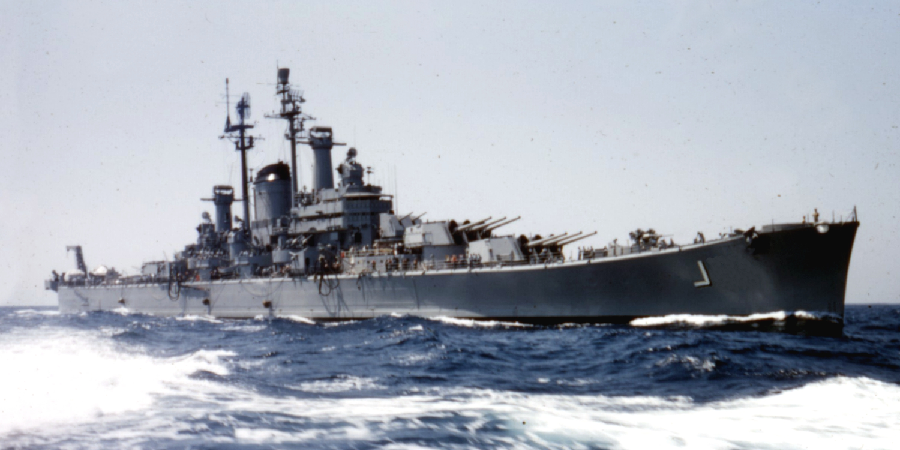
Battleship number 1, Mardo, at sea. Originally intended as the first ship of the dozen-ship Capital-class, Mardo- a 220-metre hunk of steel many nations would consider a mid-range cruiser- was designed and launched in the 1990s, during yet another wave of Astarese grandstanding in the face of the Commonwealth's existence. Many advanced features were planned for the vessel- from guided missiles to a full-scale nuclear reactor- but the only ones that made it in were its helicopter pad and its air conditioning system. Mardo today remains the only ship in its class ever completed, with two scrapped during construction and one supposedly still under construction as new features are added, but it is still the largest ship in the Astarese navy- and as such it takes the pride of place in an oceangoing group, accompanied by several frigates and a frigate leader cruiser.
It notably does not have authority over organizations such as the Armed Public Security, Commonwealth Guard (military guard of Astarese politicians), the Astarey Protection Guild (an intelligence agency), the National-Regional Guard (smaller militias and militaries belonging to individual Regions, including several Interregional Unified Guard forces such as the Apiran Republic Army), and oddly the NNCA Survey Establishment & Meteorological Forces; which are handled separately. It has often been proposed that the NNCA-Coastal Guard be split off from the NNCA proper, as it already operates under largely separate authority, but this has not come to pass so far. In addition, several Forces operated firefighting services for Astarese cities; these are now independent.
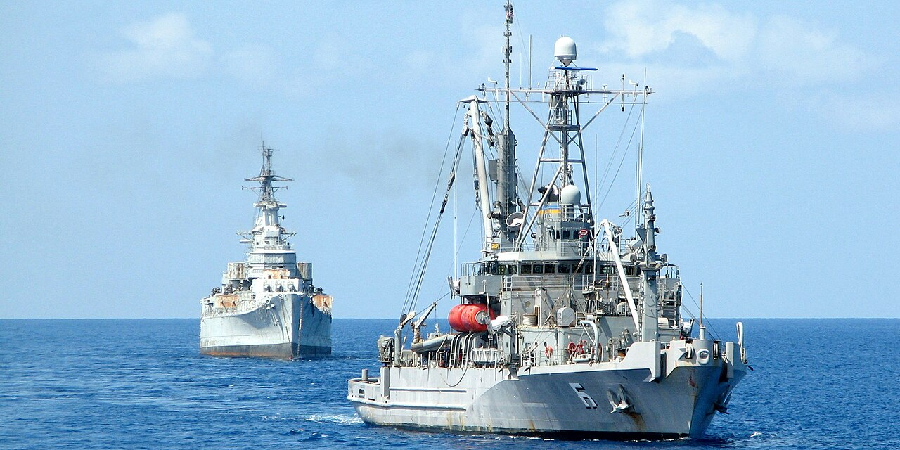
Salvage/Towing Ship #7 Program J-7 pulls the hulk of Mardo's unnamed sister ship Battleship #3, damaged beyond repair after decades of neglect.
As a result of this multifaceted division of forces, Astarey's seagoing vessels, armored vehicles, and aircraft are split between the Forces and Commands so intensely that it is often hard to get any work done. The disposition of Astarey's 280 naval vessels (165 warships and 115 auxilliaries), including only self-mobile large vessels of a determined class of vessels (what the NNCA calls "regular ships", an arbitrary classification that often excludes smaller unarmed vessels despite including large noncommissioned ships), is thus:
- NNCA Surface Naval Forces: 88 warships, 44 auxilliary ships
- Heavy Combatant Command: 1 warship (1 under construction)
- 1 Capital-class Battleship (~22,000 tons displacement, considered a cruiser externally; faceclaim USS Newport News (Des Moines-class Heavy Cruiser))
- Carrier & Amphibious Command: 17 warships, 1 auxilliary ship (3 under construction)
- 2 Patriotism-class Aircraft Carriers (~17,000 tons displacement, considered a light carrier externally; faceclaim Minas Gerais (Colossus/Majestic-class Light Carrier))
- 3 Valor-class Aircraft Carriers (~13,000 tons displacement, considered a light carrier externally; faceclaim Dédalo (Independence-class Light Carrier))
- 3 Region-class Helicopter Carriers (~11,000 tons displacement, considered an amphibious assault ship/helicopter carrier externally; faceclaim USS Inchon (Iwo Jima-class Amphibious Assault Ship))
- 4 Region-class Amphibious Assault Ships (~18,000 tons displacement, same class as above with different loadout)
- 1 Lake II-class Amphibious Command Ship (~16,400 tons displacement, considered an amphibious assault ship externally; faceclaim USS Coronado (Austin-class Amphibious Transport Dock))
- 4 Lake-class Amphibious Landing Platforms (~13,600 tons displacement, considered an amphibious transport dock externally; faceclaim USS Raleigh (Raleigh-class Amphibious Transport Dock))
- 1 Contentedness-class Support Carrier (~28,000 tons displacement, considered an amphibious assault ship/hospital ship externally; faceclaim RFA Argus)
- Fleet Command: 44 warships (4 under construction)
- 1 Fogiretesz-class Heavy Command Cruiser (~14,000 tons displacement, considered a light cruiser externally; faceclaim USS Northampton (Baltimore/Oregon City-class Cruiser))
- 7 Municipality-class Missile Cruisers (~15,000 tons displacement, considered a light missile cruiser externally; faceclaim USS Providence (Cleveland/Providence-class Missile Cruiser))
- 3 City-class Cruisers (~10,000 tons displacement, considered a light cruiser externally; faceclaim HMS Blake (Fiji/Minotaur/Tiger-class Light Cruiser))
- 6 Reczad-class Missile Cruisers (~7,000 tons displacement, considered a missile destroyer externally; faceclaim USS Wainwright/Harry E. Yarnell (Belknap/Leahy-class Missile Destroyer))
- 11 Steadfast-class Frigates (~5,000 tons displacement, considered a frigate externally; faceclaim INS Rajput (Rajput-class Missile Destroyer))
- 7 Swift-class Frigates (~3,000 tons displacement, considered a frigate externally; faceclaim HNLMS Friesland (Friesland-class Missile Destroyer))
- 9 Badger-class Corvettes (~1,500 tons displacement, considered a corvette externally; faceclaim Infanta Elena (Descubierta-class Corvette))
- Riverine Prefecture: 26 warships (1 under construction)
- 2 Crocodile-class Frigates (~4,000 tons displacement, considered a frigate externally; faceclaim Impavido (Impavido-class Missile Destroyer)
- 6 Snake-class Corvettes (~2,000 tons displacement, considered a corvette externally; faceclaim KD Lekir (Kasturi-class Corvette))
- 7 Toad-class Patrol Boats (~900 tons displacement, considered a minesweeper externally; faceclaim USS Inflict (Agile/Aggressive-class Minesweeper))
- 11 Gecko-class Patrol Boats (~400 tons displacement, considered a patrol boat externally; faceclaim USS Tempest (Cyclone-class Patrol Boat))
- Sealift & Auxilliary Command: 43 auxilliary ships (4 under construction)
- 8 Program E7-class Depot Ships (~9,700 tons displacement, considered a destroyer/submarine tender externally; faceclaim USS Sperry/Proteus (Dixie/Fulton-class Submarine/Destroyer Tender))
- 4 Program H4-class Repair Ships (~16,200 tons displacement, considered a repair ship externally; faceclaim USS Hector (Vulcan-class Repair Ship))
- 7 Program C6-class Fleet Cargo Ship (~14,000 tons displacement, considered a cargo/landing ship externally; facelaim USS Wyandot (Andromeda-class Attack Cargo Ship))
- 5 Program F7-class Fleet Supply Ships (~15,500 tons displacement, considered a stores ship externally; faceclaim USS Pyro (Nitro-class Ammunition Ship))
- 2 Program D3-class Fleet Oilers (~34,000 tons displacement, considered a replenishment tanker externally; faceclaim RFA Olwen (Ol-class Fast Fleet Tanker))
- 6 Program J3-class Salvage/Towing Ships (~3,300 tons displacement, considered a salvage ship externally; faceclaim USNS Grasp (Safeguard-class Rescue and Salvage Ship))
- 11 Program G16-class Ocean Tugboats (~2,300 tons displacement, considered a tugboat externally; faceclaim USNS Narragansett (Powhatan-class Fleet Ocean Tugboat))
- NNCA Submarine Naval Forces: 38 warships, 14 auxilliary ships
- Fleet Submarine Command: 7 warships (1 under construction)
- 4 Tuna-class Attack Submarines (~2,500 tons displacement, considered an attack submarine externally; faceclaim INS Kursura (Kalvari-class Submarine))
- 3 Barracuda-class Attack Submarines (~1,400 tons displacement, considered an attack submarine externally; faceclaim HMS Alliance (Amphion-class Submarine))
- Cruiser Submarine Command: 5 warships
- 2 Orca-class Cruiser Submarines (~4,300 tons displacement, considered a cruiser submarine externally; faceclaim Surcouf (Surcouf-class Submarine))
- 3 Dolphin-class Cruiser Submarines (~2,500 tons displacement, considered an attack submarine externally; faceclaim K-21 (K-class Submarine))
- Missile Submarine Command: 6 warships (1 under construction)
- 2 Shark-class Missile Submarines (~3,800 tons displacement, considered a cruise missile submarine externally; faceclaim ? (Juliett-class Submarine))
- 4 Ray-class Missile Submarines (~2,800 tons displacement, considered a cruise missile submarine externally; faceclaim USS Grayback (Grayback-class Submarine))
- Coastal Command: 20 warships, 5 auxilliary ships (6 under construction)
- 7 Perch 73-class Coastal Submarines (~600 tons displacement, considered a coastal submarine externally; faceclaim IRIS Fateh (Fateh-class Submarine))
- 6 Perch 49-class Coastal Submarines (~500 tons displacement, considered a coastal submarine externally; faceclaim M-296 (Quebec-class Submarine))
- 7 Perch 60-class Coastal Submarines (~100 tons displacement, considered a mini submarine externally; faceclaim Ghadir-class submarine)
- 5 Cormorant-class Oceanographic Surveyors (~4,300 tons displacement, considered a spy ship externally; faceclaim Kavkaz (Primor'ye-class Spy Ship))
- Rescue Submarine Command: 9 auxilliary ships
- 2 Pelican-class Submarine Rescue Tenders (~10,000 tons displacement, considered a submarine tender externally; faceclaim ? (Type 925 Dajiang Submarine Support Ship))
- 4 Manatee-class Rescue Submarines (~7,000 tons displacement, considered a transport submarine externally; faceclaim ? (India-class Submarine))
- 3 Merganser-class Submarine Rescue Ships (~4,000 tons displacement, considered a submarine rescue ship externally; faceclaim USS Ortolan (Pigeon-class Submarine Rescue Ship))
- NNCA Coastal Guard: 27 warships, 2 auxilliary ships
- Littoral Service: 18 warships (5 ships under construction)
- 1 Osprey-class Cruisers (~8,000 tons displacement, considered a destroyer externally; faceclaim Admiral Kharlamov (Udaloy-class Destroyer))
- 4 Eagle-class Frigates (~3,000 tons displacement, considered a frigate externally; faceclaim Vozbuzhdeny (Kotlin-class Destroyer))
- 2 Falcon-class Frigates (~1,500 tons displacement, considered a minelayer/corvette externally; faceclaim Pohjanmaa (Pohjanmaa-class Minelayer))
- 6 Kestrel-class Corvettes (~700 tons displacement, considered a corvette/patrol boat externally; faceclaim Vikhr (Nanuchka-class Corvette))
- 5 Shrike-class Corvettes (~300 tons displacement, considered a minesweeper/patrol boat externally; faceclaim Ueckermünde (Kondor-class Minesweeper))
- Revenue Service: 9 warships, 2 auxilliary ships
- 9 Shrike-class Corvettes (same class as above)
- 2 Versatile-class Ocean Survey Ships (~2,300 tons displacement, same class as Versatile-class Tracking Ship; faceclaim USNS Capable (Stalwart-class Ocean Surveillance Ship))
- NNNCA Auxilliary Forces: 1 warship, 26 auxilliary ships
- Joint Logistical Command: 18 auxilliary ships (2 under construction)
- 5 Program B6-class Large Landing Ships (~5,700 tons displacement, considered a tank landing ship externally; faceclaim INS Magar (Magar-class Amphibious Warfare Vessel))
- 3 Program A15-class Small Landing Ships (~1,100 tons displacement, considered a tank landing ship externally; faceclaim n/a (Kumbhir-class Tank Landing Ship))
- 5 Program E1-class Depot Ships (~3,100 tons displacement, considered a tender externally; faceclaim Dmitriy Galkin (Don-class Submarine Tender))
- 3 Program D5-class Fleet Oilers (~18,200 tons displacement, considered a replenishment oiler externally; faceclaim Durance (Durance-class Replenishment Oiler))
- 2 Program F12-class Fleet Supply Ships (~23,400 tons displacement, considered a replenishment ship externally; faceclaim RFA Fort Rosalie (Fort Rosalie-class Replenishment Ship))
- Research Command: 1 warship, 8 auxilliary ships
- 1 Discovery-class Icebreaker (~6,000 tons displacement, considered a patrol icebreaker externally; faceclaim USS Edisto (Wind-class Icebreaker))
- 1 Explorer-class Oceanographic Surveyor (~4,500 tons displacement, considered an oceanographic research ship externally; faceclaim USNS Hayes (Hayes-class Oceanographic Research Ship)
- 7 Versatile-class Ocean Survey Ships (same class as Versatile-class Tracking Ship; faceclaim USNS Stalwart (Stalwart-class Ocean Surveillance Ship))
- NNCA Ground Forces Supply Branch: 14 auxilliary ships (1 under construction)
- 2 NNCA-GF-SB-C-class Heavy Landing Ships (~8,300 tons displacement, considered a tank landing ship externally; faceclaim USS Barbour County (Newport-class Tank Landing Ship))
- 5 NNCA-GF-SB-E-class Logistical Support Ships (~4,300 tons displacement, considered a tank landing ship externally; faceclaim BRP Dagupan City (Bacolod City-class Logistics Support Vessel))
- 7 Program A15-class Small Landing Ships (~1,100 tons displacement, considered a tank landing ship externally; faceclaim INS Cheetah (Kumbhir-class Tank Landing Ship))
- NNCA Rocket Forces Telemetry & Radar Command: 10 auxilliary ships
- 1 NCCA-RF-TRC-1-class Tracking Ship (~22,000 tons displacement, considered a tracking ship externally; faceclaim USNS Vanguard)
- 3 NCCA-RF-TRC-2-class Communications Ships (~4,900 tons displacement, considered a spy ship externally; faceclaim Lira (Balzam-class Intelligence Ship)
- 6 Versatile-class Tracking Ships (~2,300 tons displacement, considered a tracking ship externally; faceclaim USNS Invicible (Stalwart-class Ocean Surveillance Ship))
- NNCA Naval Aviation Forces Independent Transport Command: 4 warships, 5 auxilliary ships
- 1 Magnificent-class Aircraft Carrier (~9,600 tons displacement, considered a helicopter cruiser externally; faceclaim Vittorio Veneto)
- 3 Inspiring-class Helicopter Carriers (~3,100 tons displacement, considered a helicopter destroyer externally; faceclaim HMCS Margaree (St. Laurent-class Destroyer Escort))
- 2 Pedagogy-class Training Carriers (~6,600 tons displacement, considered a landing platform externally; faceclaim USS Sable)
- 3 Distillation-class Training Helicopter Carriers (~400 tons displacement, considered a landing platform externally; faceclaim Baylander)
- NNCA Naval Infantry Forces Amphibious Landing Command: 7 warships (2 under construction)
- 1 Re Sildo-class Amphibious Command Ship (~19,000 tons displacement, considered an amphibious command ship externally; faceclaim USS Mount Whitney (Blue Ridge-class Amphibious Command Ship))
- 3 Region-class Amphibious Assault Ships (~18,000 tons displacement, considered an amphibious assault ship/helicopter carrier externally; faceclaim n/a (Iwo Jima-class Amphibious Assault Ship)))
- 3 River-class Amphibious Landing Platforms (~8,500 tons displacement, considered a landing platform dock externally; faceclaim Ouragan (Ouragan-class Landing Platform Dock))
Of special note are the Valor-class Aircraft Carriers and Municipality-class Cruisers- while their construction did not overlap, the Valor-class design was one of two programs for the uprating of the Municipality-class cruisers- the other converting the seven remaining ships of the class to guided missile ships. Additionally, upsized versions of the Municipality-class became the basis for the single-ship Fogiretesz-class Command Cruiser and Capital-class Battleship- similar processes occured to produce most of the NNCA's other command ships.
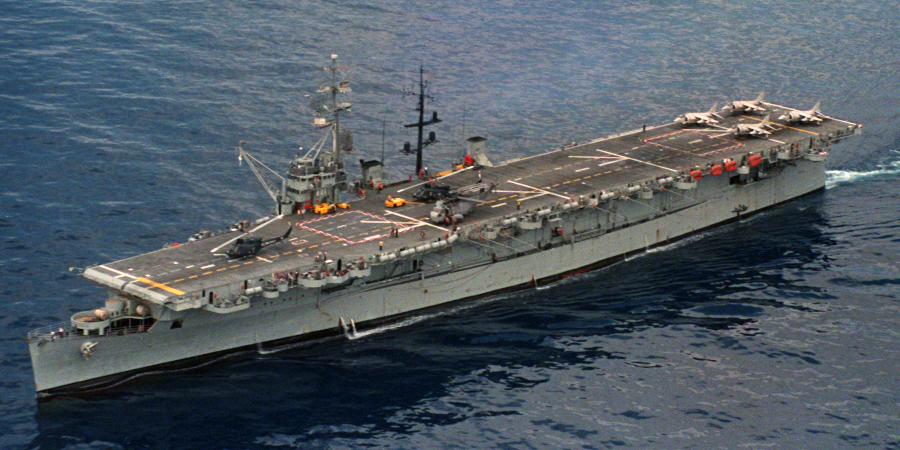
The Valor itself, Carrier #20...
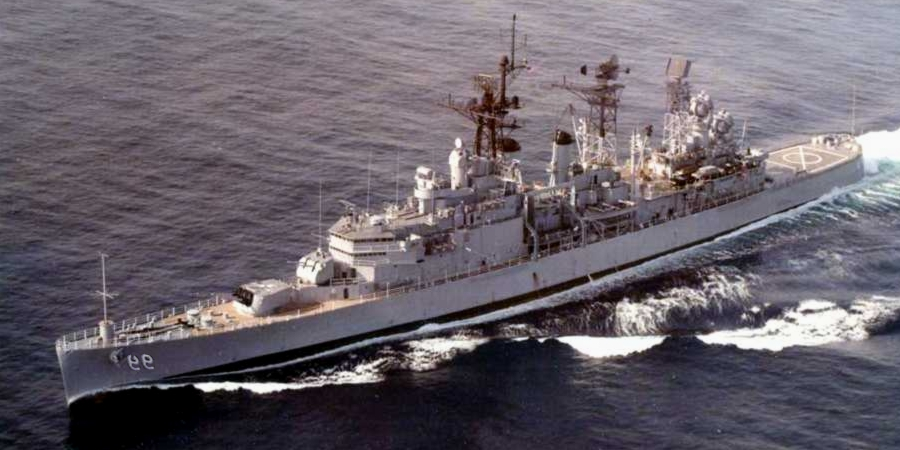
...and a typical Astarese Municipality-class Cruiser, #46.
The prevailing setup for warship naming in Astarey is themed per type or class, with a class often being named for its naming theme. Otherwise, classes are named for the first-launched ship of the class- even if said ship is not the first-numbered or planned. Cruisers and other large surface combatants are named for the cities of Astarey, including the battleship Mardo in its capacity as a Capital-class battleship named after a former capital of Astarey. Aircraft carriers are named after "National Virtues", while amphibious assault ships are named for the regions of Astarey.

A representative Region-class ship, #12, here serving as a helicopter carrier.
Frigates, being smaller than cruisers, were initially named after towns in Astarey; but now are named after coordinates to virtues- Steadfast for Loyalty, Swift for Decisive. Patrol vessels, including larger ships belonging to the NNCA Coastal Guard and NNCA-SNF Riverine Riverine Prefecture are named for animals, especially those that hunt- the Coastal Guard prefers birds, the Riverine Prefecture prefers land animals. Submarines are named after sea life- cruiser submarines being marine mammals, missile submarines being cartaliginous fish, attack submarines being other predatory fish, and coastal submarines simply being Perch [number].

Frigate #79, the Steadfast-class frigate Honorable, on its first cruise after commissioning on 21 May 2021.
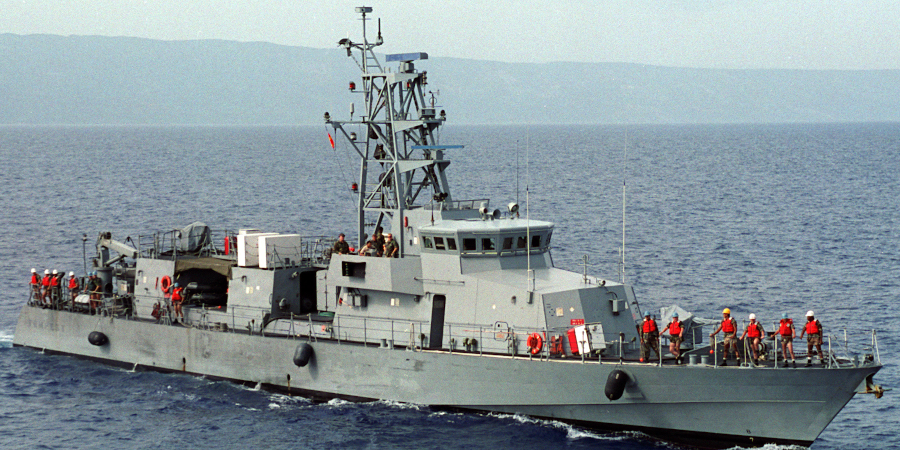
A Gecko-class patrol boat of the Riverine Prefecture.
Most auxilliary vessels, especially those outside the NCAA-AF Joint Logistical Command or NCAA-SNF Sealift & Auxilliary Command, only have nicknames- these are not reproduced, and are only seldom recorded; often a crew will be entirely unaware of the ship's prior nicknames. The Office of Naval Construction, obstensibly having the mission to assign such meaning-schemes, tends to simply leave Astarey's many military forces to figure it out for themselves- only applying a project number, often a simple sequential number- though individual branches will usually make their own simple designation instead of using that.
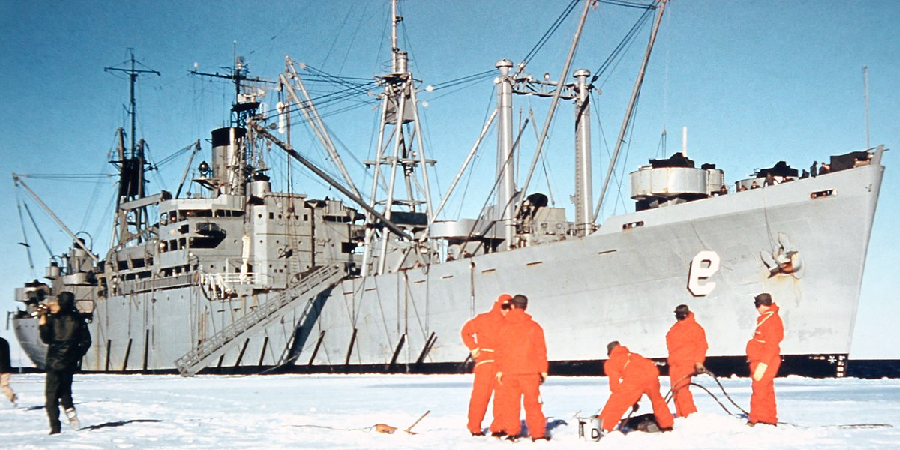
Fleet Cargo Ship Program C #6, nicknamed "Old Fesíba", during the disastrous First Astarese Tramuntanic Expedition
Astarey is one of the few remaining nations to operate large independent gun-carrying oceangoing submarines, also known as cruiser submarines. These five ships are quite old, having been designed in the late 1960s. Though able to carry aircraft (including the occasional helicopter) and large weaponry like Astarey's major warships of the time, this capability proved more of a hindrance- especially as the 80s rolled on and Astarese vessels began to be designed with missile armament in mind. By the early 1990s, then, as designs like Battleship #1 Mardo and the Patriotism-class light aircraft carrier left the realm of blueprint and entered the Astarese navy, the Submarine Naval Forces saw the perfect opportunity to design a truly grand vessel. Envisioned as a unification of the four Submarine Commands, the massive Whale design would carry the finest in Astarese weaponry and be an undetectable behemoth, unstoppable above or below the waves.
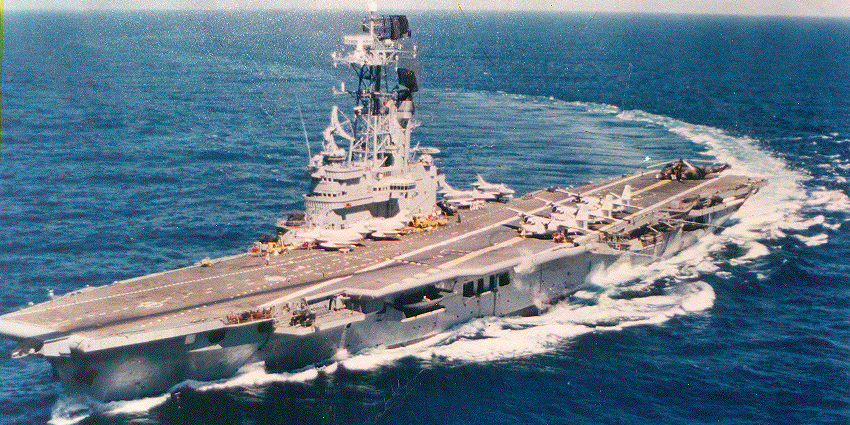
The Patriotism-class carrier Loyalty after its 2003 upgrade, carrying a somewhat characteristic Astarese mix of jets, propeller aircraft, and helicopters.
Many of its design features were inspired by those present on the submarines of other nations, from nearby Novoroyska's relatively recently-launched Omega-class and its separate internal pressure vessels to faraway Jezabelstein's vast arsenal of submarine-launched missiles to highly disturbing rumors of "indefinite-submergence" vessels produced by the hated Meridian Commonwealth. It would feature Astarey's first naval nuclear reactor, and carry dozens more nuclear warheads onboard in the form of ballistic missiles, cruise missiles, and nuclear-tipped torpedoes- not to mention an internal hangar for the Perch 40-class miniature submarines of the Coastal Command.

One of the later Perch 60-class miniature submarines, launched in the early 2000s in a bid to expand Astarey's spy delivery capability.
New features were added to the design almost every day, but what really killed the project was a turn in geopolitics. Publically snubbed in Jezabelstien, Astarey's newly-crowned Sovereign Danjél Zechéja returned to the desk to discover a proposal from the Submarine Naval Forces suggesting an agreement to provide Jezabelstein with political support in exchange for the advice, expertise, and materials necessary to build the first Whale- a proposal that, naturally, could not be abided. The project was quickly cancelled, but some aspects of its design eventually made it to the water- the two Shark-class missile submarines, launched in 2002, each have built-in launch tubes for high-explosive-armed cruise missiles, and the project that ultimately saved the Ray-class missile submarine from cancellation in the wake of its primary armament being infeasible entailed outfitting its integral cruise missile hangars with provisions for use with miniature Coastal Command-operated "delivery vehicles".
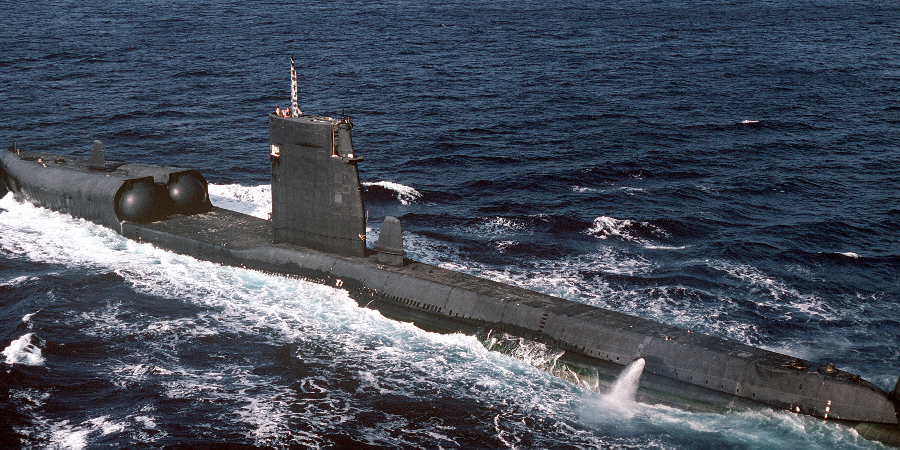
The Ray-class submarine Torpedo, its double hangars visible. Not visible are the changes made to them- Torpedo serves as a permanent hub for small Coastal Command "wet subs", allowing spies and special forces to go ashore under the cover of more standard Astarese military grandstanding.


Carrier #21, Integrity, docked at Joint Naval Station Aruda. In the first picture it is across from Amphibious Landing Platform #4 Lake Erchani. In the second its piermate is Cruiser #68, of the then-new Reczad class of missile cruiser.
Return to main page.













